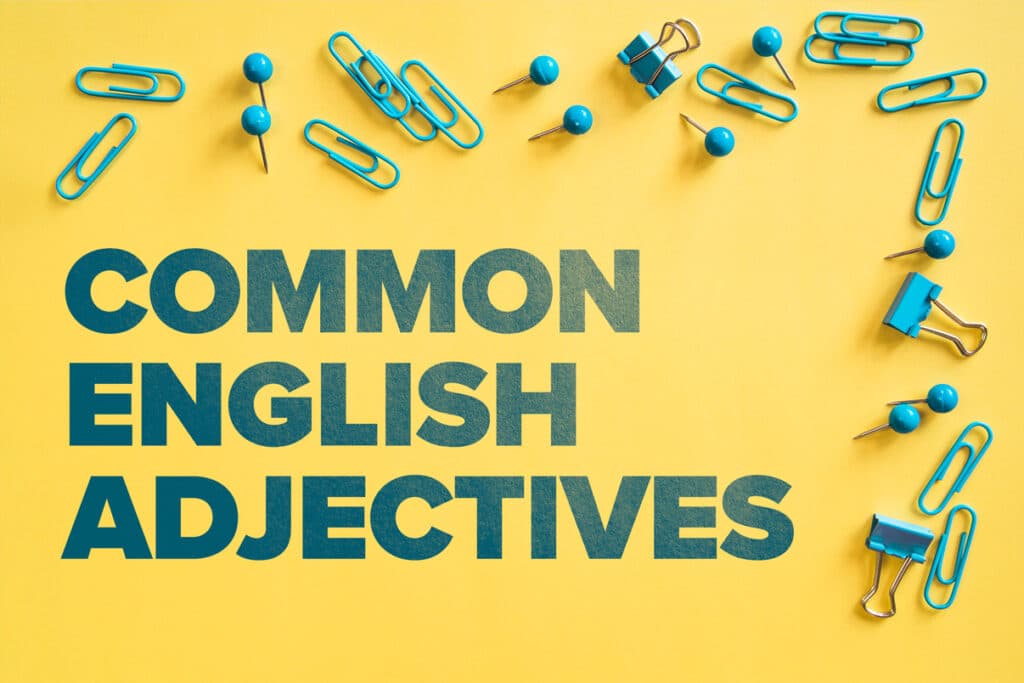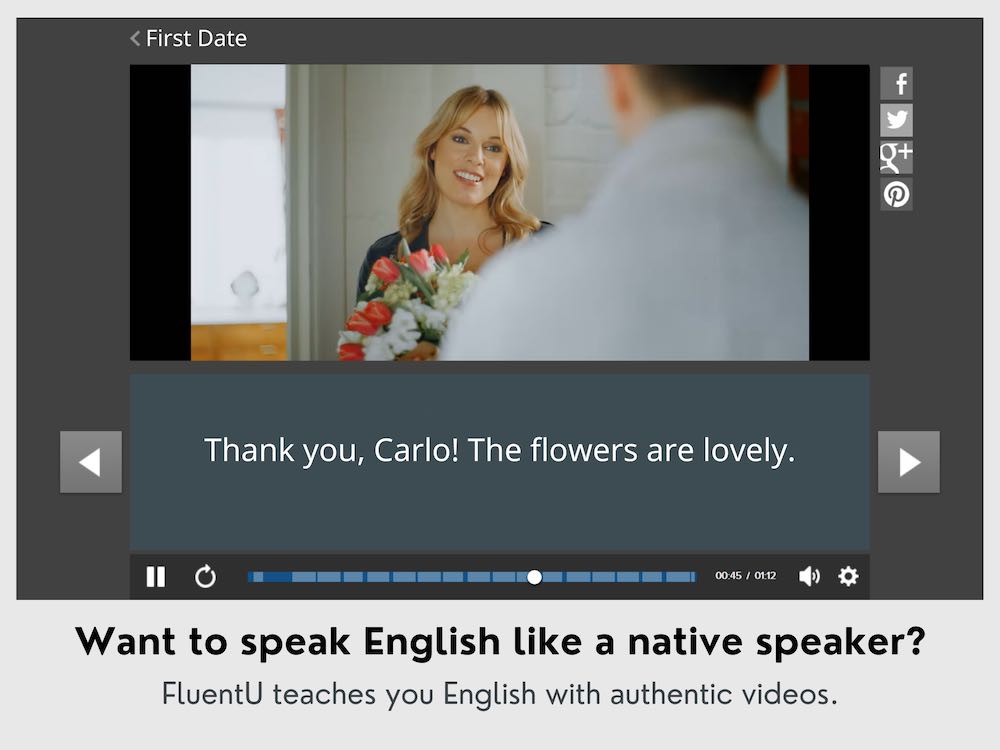
58 Must-know English Adjectives
Adjectives are words that describe nouns, pronouns and other adjectives and can add important information. But that’s not all.
Words like “every,” “the” and “my” are also adjectives.
Adjectives are used much more often than even native speakers think. They are useful tools for speaking English well, so learning how to use them correctly is important.
So in this post, you’ll learn 58 common English adjectives and everything you need to know about using them correctly.
Contents
- 1. Descriptive Adjectives
- 2. Quantitative Adjectives
- 3. Demonstrative Adjectives
- 4. Possessive Adjectives
- 5. Interrogative Adjectives
- 6. Distributive Adjectives
- 7. Articles
- And One More Thing...
Download: This blog post is available as a convenient and portable PDF that you can take anywhere. Click here to get a copy. (Download)
1. Descriptive Adjectives
Descriptive adjectives describe nouns and pronouns in English.
Here’s a full list of 58 descriptive adjectives in English:
| Common Adjectives in English | |
|---|---|
| Amused | Hungry |
| Angry | Impatient |
| Annoying | Indifferent |
| Anxious | Insecure |
| Beautiful | Irritated |
| Bored | Joyful |
| Calm | Lazy |
| Chaotic | Lonely |
| Cheerful | Loud |
| Confused | Miserable |
| Cute | Nervous |
| Delighted | Nice |
| Depressed | Optimistic |
| Determined | Overwhelmed |
| Disappointed | Peaceful |
| Distracted | Pessimistic |
| Energetic | Playful |
| Enthusiastic | Proud |
| Excited | Relaxed |
| Exhausted | Relieved |
| Fearful | Restless |
| Focused | Sad |
| Forgetful | Satisfied |
| Frustrated | Silly |
| Grateful | Stressed |
| Grumpy | Surprised |
| Guilty | Tall |
| Happy | Tired |
| Hopeful | Worried |
Examples:
The beautiful flowers have a nice smell
The cat is hungry
Her new shirt is so cute
The 3 Degrees of Descriptive Adjectives
Descriptive adjectives can be positive, comparative or superlative. When you use them depends on how many things you’re talking about.
- A positive adjective: a normal adjective that’s used to describe, not compare. For example: “This is good soup” and “I am funny.”
- A comparative adjective: an adjective that’s used to compare two things (and is often followed by the word than). For example: “This soup is better than that salad” or “I am funnier than her.”
- A superlative adjective: an adjective that’s used to compare three or more things, or to state that something is the most. For example: “This is the best soup in the whole world” or “I am the funniest out of all the other bloggers.”
These three degrees only work for descriptive adjectives.
If a descriptive adjective has one or two syllables, you can turn it into its comparative and superlative forms by adding -er and -est. For example:
loud → louder → loudest
Descriptive adjectives with three or more syllables don’t use the -er and -est endings.
For example, the word beautiful can’t be turned into beautifuler or beautifulest—those aren’t words!
Instead, you add the words more and the most before it to turn it into a comparative or superlative adjective:
Beautiful → more beautiful → the most beautiful
There are some exceptions to these rules, as with most grammar rules. For example, good only has one syllable, but it turns into better and best.
2. Quantitative Adjectives
Quantitative adjectives describe the quantity of something.
In other words, they answer the question “how much?” or “how many?”
Numbers like one and thirty are this type of adjective. So are more general words like many, half and a lot.
Examples:
I only have one daughter
I want many children!
I can’t believe I ate that whole cake!
3. Demonstrative Adjectives
A demonstrative adjective describes “which” noun or pronoun you’re talking about.
These adjectives include the words:
- This — A singular noun close to you
- That — A singular noun far from you
- These — A plural noun close to you
- Those — A plural noun far from you
Demonstrative adjectives always come before the word they’re modifying.
Sometimes—like when responding to a question—you can leave off the noun being described and only use the adjective. For example, if someone asks you how many cakes you want to buy you can respond:
“I want to buy two cakes,” or
“I want to buy two“
Examples:
This bicycle is mine
That one used to be mine until I sold it
Those dresses belong to my sister
4. Possessive Adjectives
Possessive adjectives show possession (or, ownership).
They describe who things belong to. Some of the most common possessive adjectives include:
- My — Belonging to me
- His — Belonging to him
- Her — Belonging to her
- Their — Belonging to them
- Your — Belonging to you
- Our — Belonging to us
All these adjectives—except the word his—can only be used before a noun.
You can’t just say, “That’s my.” You have to say, “That’s my pen.”
When you want to leave off the noun or pronoun being modified, use these possessive adjectives instead:
- Mine
- His
- Hers
- Theirs
- Yours
- Ours
For example, even though saying “That’s my” is incorrect, saying “That’s mine” is perfectly fine.
Examples:
That’s my dog
The red cup is hers
His son has blonde hair
5. Interrogative Adjectives
Interrogative adjectives ask a question.
These adjectives are always followed by a noun or a pronoun and are used to form questions. The interrogative adjectives are:
- Which — Asks to choose between options
- What — Asks to make a choice (in general)
- Whose — Asks who something belongs to
Other question words like “who” or “how” aren’t adjectives since they don’t modify nouns.
For example, you can say “whose coat is this?” but you can’t say “who coat?”
Which, what and whose are only considered adjectives if they’re immediately followed by a noun. The word which is an adjective in this sentence: “Which color is your favorite?” But not in this one: “Which is your favorite color?”
Examples:
Which song will you play on your wedding day?
What pet do you want to get?
Whose child is this?
6. Distributive Adjectives
Distributive adjectives describe specific members of a group. These adjectives are used to single out one or more individual items or people. Some of the most common distributive adjectives include:
- Each — Every single one of a group (used to speak about group members individually)
- Every — Every single one of a group (used to make generalizations)
- Either — One between a choice of two
- Neither — Not one or the other between a choice of two
- Any — One or some things out of any number of choices. This is also used when the choice is irrelevant, like: “it doesn’t matter, I’ll take any of them.”
These adjectives are always followed by the noun or pronoun they’re modifying.
Examples:
Every rose has its thorn
I don’t like either song
I don’t want any food
7. Articles
There are only three articles in the English language: a, an and the.
Articles describe which noun you’re referring to.
- A — A singular, general item
- An — A singular, general item. Use this before words that start with a vowel
- The — A singular or plural, specific item
Simply put, when you’re talking about something general, use a and an.
When you’re talking about something specific, use the.
For example, “A cat” can mean any cat in the world. “The cat” refers to a specific cat, maybe one that just walked by.
Examples:
The elephants left huge footprints in the sand
An elephant can weigh over 6,000 pounds
Congratulations! You now know 58 English adjectives and the seven adjective types.
But don’t just learn rules for adjectives and complete practice exercises. Listen to lots of English speakers so you can experience adjectives used in real life.
You can also use FluentU for this, which uses short English videos to teach you English.
FluentU takes authentic videos—like music videos, movie trailers, news and inspiring talks—and turns them into personalized language learning lessons.
You can try FluentU for free for 2 weeks. Check out the website or download the iOS app or Android app.
P.S. Click here to take advantage of our current sale! (Expires at the end of this month.)

Adjectives make your sentences sound natural and more fluent. So get comfortable with them and use them as often as you can!
Download: This blog post is available as a convenient and portable PDF that you can take anywhere. Click here to get a copy. (Download)
And One More Thing...
If you like learning English through movies and online media, you should also check out FluentU. FluentU lets you learn English from popular talk shows, catchy music videos and funny commercials, as you can see here:
The FluentU app and website makes it really easy to watch English videos. There are captions that are interactive. That means you can tap on any word to see an image, definition, and useful examples.
For example, when you tap on the word "searching," you see this:
Learn all the vocabulary in any video with quizzes. Swipe left or right to see more examples for the word you’re learning.

FluentU helps you learn fast with useful questions and multiple examples. Learn more.
The best part? FluentU remembers the vocabulary that you’re learning. It gives you extra practice with difficult words—and reminds you when it’s time to review what you’ve learned. You have a truly personalized experience.
Start using the FluentU website on your computer or tablet or, better yet, download the FluentU app from the iTunes or Google Play store. Click here to take advantage of our current sale! (Expires at the end of this month.)











